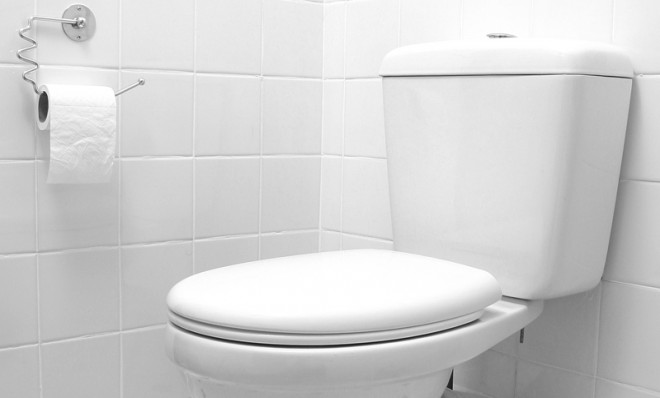5 ordinary things that save your life every day without you knowing it
It's time to stop taking your toilet for granted


1. Tap water
Water is problematic. You need it to live, but it's practically aching to kill you. Naturally occurring water, even when not soiled by human contact, can be swimming with an untold number of murderous micro-organisms.
Now, tap water, which is decidedly non-fatal, has gotten a bad rap in recent years. We believe it's just not as pure as our favored bottled water, the source of which, (we're subconsciously convinced), sprang straight from the heart of an ice-blue glacier.
The Week
Escape your echo chamber. Get the facts behind the news, plus analysis from multiple perspectives.

Sign up for The Week's Free Newsletters
From our morning news briefing to a weekly Good News Newsletter, get the best of The Week delivered directly to your inbox.
From our morning news briefing to a weekly Good News Newsletter, get the best of The Week delivered directly to your inbox.
Treated tap water may not be nearly as palatable as Evian, but it's ubiquitous, affordable, and you can drink it without getting sick or dying. For most of history, that simply wasn't true.
Tap water is brilliant. It is the result of a complex system of collection, storage, purification, and transportation. Common waterborne illnesses have been laying waste to humanity all over the world for all of time. Diseases like botulism, cholera, E.coli, Legionnaires' disease, Hepatitis A, SARS, and all the sicknesses that killed your family when you played Oregon Trail. ("Yoda has died of typhoid.") These diseases still ravage the third world. But where there is regulated tap water, they are rare. Tap water is often safer than the stuff that comes from random, untested "natural" springs, which can be contaminated with everything from sewage run-off to dangerously excessive fluoride dissolved out of granite.
There are endless controversies regarding the methods taken to make tap water potable. Depending on the needs of the water source, a cocktail of chemicals might be added to make the water drinkable. And even if the amounts used have been proven safe, people don't like thinking that they're giving their sun-flushed children a tall icy glass of teeth-strengthening disinfectant to cool off. But thousands of dead bodies buried along the real Oregon Trail, most of whom died from water-related illnesses ("don't poop where you drink" is a disturbingly new concept) call out that there are worse alternatives to the plastic aftertaste of chlorinated water.
2. Refrigerators
A free daily email with the biggest news stories of the day – and the best features from TheWeek.com
Fresh meat rots. Unless you completely change its constitution by dehydrating, smoking, salting, or canning meat, microscopic organisms will began devouring it, leaving putrid waste behind. They live in the animal when it is still alive, and more come into contact with the meat in every stage of its preparation. Basically, when it comes to eating a good fresh steak, it's you against the bacteria.
Rotting is bad because your body hates all the bacteria and fungi that are consuming that meat. Your digestive tract hates them so much it will turn itself into a sluice-run for however long it takes to get all that gross stuff out of you. And your guts really don't care if you die of dehydration on the way to that goal. It's not just animal products, either. Even fresh greens are halfway to moldy slush once cut from their roots.
Your refrigerator slows all those bacteria down. Makes them sleepy and sluggish, giving you more time to eat safe, fresh food. It makes the constant chess game your body plays against foreign pathogens slightly more in your favor. It also allows for the transportation of food, which is why you get to eat fresh fruits and vegetables in January, when your great grandparents were force-fed canned spinach with spongy potatoes.
3. Road markings
The U.S uses many road markings to communicate with drivers, some of which, let's admit, are utterly baffling. But the purest one, the right-hand-side white line, might be the most useful. Its function? To assure you. To keep a driver calm and aware. When all other sources of orientation are obscured, by fog, darkness, rain or falling snow, that white line on the side of the road is most likely to still be visible. If your night vision is poor, or if the high beams of the oncoming highway traffic make you nervous, there remains the quiet white line to steady your focus. The lines reflects the beam of your headlights and allows you to be sure of your place on the road, that you're neither drifting into traffic, or off a cliff. A recent study done in England compared accidents before and after white line road markings were updated. In the area studied, accidents went from 16 to 6. Accidents that occurred on wet nights disappeared altogether, as did serious accidents.
4. Bug spray
"Pesticides" and "herbicides" are such ugly words, aren't they? Spraying poisonous chemicals over our environment and food just to keep the occasional mosquito and ladybug away. Of course, an even uglier word is "malaria." "Starvation" isn't pretty, either.
Eating local and organic is great if you can afford it, and if you live in a region that can provide enough local food for all its residents. But that isn't always possible. Ireland in the mid-19th century is an example of what happens when the creepy-crawlies are more terrifying than the chemicals used to kill them. Ireland's main food crop, potatoes, became blighted with disease. Nearly 1 million people starved to death because a microscopic infection spoiled their food. Herbicides prevent that from happening now, allow for mass food production, and keep food bountiful and affordable.
Pesticides also prevent disease transmitted by insects. Malaria, Lyme disease, dengue, ehrlichiosis, Rift Valley fever, and West Nile virus have killed thousands in the past, especially in hot and damp climates. Malaria was so prevalent during the building of the Panama Canal that an enormous, chemically mosquito-killing campaign had to be instigated before it could be completed. Pesticides are not perfect, but their risk-to-reward ratio is satisfactory to most consumers.
5. Toilets
Continuing on the theme of deadly things that go in and out of your body, your toilet is the magnum opus of civilization. The outhouse was the primary predecessor to the toilet in the western world, and they weren't so great. A hole in the ground was a fairly decent place to store excrement, except when the sewage seeped into water tables. Not to mention there wasn't enough room for everyone to have a proper, sanitary(ish) outhouse in high-population areas. Urban citizens found outhouses impractical. They usually preferred pooping in pots. If you were rich, the contents of the pot were collected by servants and disposed of in a latrine, or river, or wherever. If you weren't rich, you threw it out the window.
Basically, feces was everywhere. Especially in cities. And feces kills people. It's called the Fecal-Oral Route of Disease Transmission and it is just as horrible as it sounds. Toilets changed all of that. Your toilet is connected to beautiful pipes, pipes that end in water-tight reinforced septic tanks, or a city sewage treatment plant. Your toilet is one of the reasons you are not likely to be part of the 3.4 million people who die of waterborne illness each year.
Therese O'Neill lives in Oregon and writes for The Atlantic, Mental Floss, Jezebel, and more. She is the author of New York Times bestseller Unmentionable: The Victorian Ladies Guide to Sex, Marriage and Manners. Meet her at writerthereseoneill.com.
-
 Political cartoons for December 20
Political cartoons for December 20Cartoons Saturday’s political cartoons include drowning rats, the ACA, and more
-
 5 fairly vain cartoons about Vanity Fair’s interviews with Susie Wiles
5 fairly vain cartoons about Vanity Fair’s interviews with Susie WilesCartoon Artists take on demolition derby, alcoholic personality, and more
-
 Joanna Trollope: novelist who had a No. 1 bestseller with The Rector’s Wife
Joanna Trollope: novelist who had a No. 1 bestseller with The Rector’s WifeIn the Spotlight Trollope found fame with intelligent novels about the dramas and dilemmas of modern women
